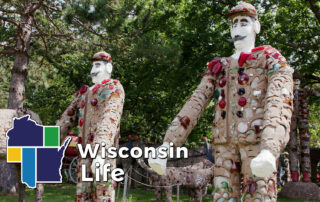Stories of life around Wisconsin include a trio of Lake Geneva mail boat jumpers and a woodcarver who captures delicate details.
This episode’s collection of stories begins in Lake Geneva, where it’s not rain, nor snow, nor sleet that worry a trio of mail carriers… it’s wind, waves and whitecaps. College-aged siblings Keith, Anna and Elle spend their summers as “mail jumpers” – following a Lake Geneva long-time tradition of delivering the U.S. Mail by way of a mail boat that never stops moving. The sibling’s mail route is a lake, where they deliver the post to mailboxes fastened to docks. Mail carriers jump from moving boat to dock – and back to moving boat again… hoping to complete their route without a dip in the drink.
Next, it’s over to Pickett, in Winnebago County, to meet Tom Tyers. Tyers hand carves and paints feathers that are so lifelike that people often mistake his work for real feathers and warn him that most people are federally prohibited from owning feathers from any native migratory bird. Take a virtual tour of Tom Tyers’ work.
Then, Dinorah Marquez, the director of Milwaukee’s Latino Arts Strings Program, shares her story. As a young girl, she grew up on the south side of the U.S.-Mexico border. When Marquez moved to the U.S. she didn’t speak any English and was quite shy and scared. Her new school had an orchestra program and Marquez would go on to find her voice through playing an instrument. Now, decades later, she hopes to give other young students who may be new to Wisconsin – and the U.S. – the same experience.
Madison resident John Rummel also shares his story. Rummel is an avid photographer who loves to work at night… in fact, he must work at night. Rummel captures the night sky in his work and composes his photos by calculating the moons trajectory over Madison.
Finally, Wisconsin Life heads to La Crosse. That’s where a group of young women move through the dead of night to leave their mark on the city’s public spaces… their cozy, soft, knitted marks. “Drop Stitch Murphy” and her renegade gang of fellow knitters engage in stealthy displays of public art. They anonymously drape library sculptures, city light posts and other public spaces in knitted forms. While the “Yarn Bombers” may be clandestine, they do always first ask “permission to drape”.







